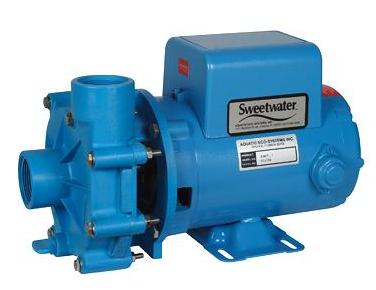Cheap Stuff And Value Engineering
When we got back from the UVI course in June 2007 we were excited about getting started in aquaponics, and immediately started pricing components. We were shocked to find that a 10′ fiberglass tank that cost $1,935 on the mainland had another $2,200 of shipping costs to get it to Hawaii. The smaller tanks we needed had similar painful price tags attached, along with everything else that had to get shipped in. The 2003 UVI “system cost” of $42,000 that they gave us during the 2007 course turned out to be $85,000 in Hawaii in 2007. This information forced us to rethink how we would build our systems, rather than just building identical systems to the ones UVI had. We started value engineering the systems instead of just shopping in catalogs.
(Below) An energy-efficient pump that only costs $678 with shipping; it pumps 40 gallons per minute, and uses $655 per year worth of electricity.
(Below) Another pump that only costs $379 with shipping; it pumps 50 gallons per minute (that’s a little better than our blue pump above). It looks cheaper on the surface, BUT it uses $6,845 per year worth of electricity, which is unacceptable compared to our blue pump above!
Which pump would you buy? Thought so.
Value engineering is when you research and develop a system component or subsystem that works just as well but costs less than your first selection. Because we had to build these systems on a limited amount of loan money (while living on the loan at the same time!) we were forced to review every single system component and subsystem to determine if there was a better way to do things. Because we knew we would forever be paying for any inefficiencies we designed into these systems, we were particularly careful to be thorough and precise in our research and design work.
Don’t confuse “Value Engineering” with “Cheap”! Don’t waste your money buying cheap pumps, air pumps, airstones, or other aquaponics equipment! We are always hearing about “I got a good cheap sump pump (or Jacuzzi pump) at a yard sale for $25. Will it work?”. Yes, it will work. However, the pumps that are specified with the different sized systems are exactly the right size for those systems, and will not use any more energy than necessary to do the job right.
Here’s an example of this problem: you buy a $25 Jacuzzi pump at a yard sale for a 64-square-foot MicroSystem instead of spending $62 (plus shipping!) for the right pump as specified in the materials list. You think you saved money, right? That’s until you realize that the right $62 pump only uses $93 of electricity a year, and the cheap pump uses $1,294 of electricity a year. This “savings” cost you an extra $1,201 a year, but go right ahead if you still feel it’s a deal.
The point here is that energy cost can be far more than any difference in original equipment cost, so you want to buy the most energy-efficient piece of equipment that will do the job, even if it costs four times as much as the cheap one! What you need to do is educate yourself, and think about energy, labor, and other costs associated with a purchase of a system component before buying it. What’s best is to find someone who’s using the same thing and has had no problems with it; the aquaponics forums are good for this. In this blog, we ONLY mention equipment by name that WORKS!
An old farmer friend on the Big Island said it best: “Cheap no good. Good no cheap”. Any time you think you’ve got a “deal”, look twice. You may be the one paying an extra $1,200 a year.